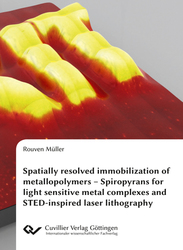| Fachbereiche | |
|---|---|
| Buchreihen (96) |
1378
|
| Nachhaltigkeit |
3
|
| Gesundheitswesen |
1
|
| Geisteswissenschaften |
2365
|
| Naturwissenschaften |
5406
|
| Mathematik | 229 |
| Informatik | 319 |
| Physik | 980 |
| Chemie | 1363 |
| Geowissenschaften | 131 |
| Humanmedizin | 243 |
| Zahn-, Mund- und Kieferheilkunde | 10 |
| Veterinärmedizin | 108 |
| Pharmazie | 147 |
| Biologie | 835 |
| Biochemie, Molekularbiologie, Gentechnologie | 121 |
| Biophysik | 25 |
| Ernährungs- und Haushaltswissenschaften | 45 |
| Land- und Agrarwissenschaften | 1004 |
| Forstwissenschaften | 201 |
| Gartenbauwissenschaft | 20 |
| Umweltforschung, Ökologie und Landespflege | 148 |
| Ingenieurwissenschaften |
1793
|
| Allgemein |
98
|
|
Leitlinien Unfallchirurgie
5. Auflage bestellen |
|
Erweiterte Suche
Spatially resolved immobilization of metallopolymers
Spiropyrans for light sensitive metal complexes and STED-inspired laser lithography
Rouven Müller (Autor)Vorschau
Inhaltsverzeichnis, PDF (550 KB)
Leseprobe, PDF (760 KB)
In the course of the present thesis, the first method for the spatially resolved surface immobilization of various metallopolymers on a single surface was developed, employing the versatile NITEC photochemistry. The in-depth analysis of the photoligation process identified crucial parameters for the successful immobilization of the metallopolymers, which are also valid for all other photo triggered surface ligation protocols. ToF-SIMS and spatially resolved XPS analysis of the prepared surfaces demonstrated the preserved chemical composition of the fabricated metallopolymer surfaces. In the second part of the thesis, the photochemistry of spiro(thio)pyrans was investigated for the formation of light-sensitive spiropyran-metal complexes, as well as the creation of a photoresist for the application in STED-inspired lithography. The irradiation of an NMR tube inside the NMR spectrometer in so-called LED-NMR experiments was introduced for the investigation of the prepared spiropyran-metal complexes. Finally, the photo triggered reaction of the spirothiopyran photoswitch with an electron deficient maleimide was used for the spatial encoding of surfaces for the first time. In addition, the preparation of a spirothiopyran-based photoresist enabled the writing of structures below the diffraction limit, with the thinnest lines written with STED-inspired lithography to date.
| ISBN-13 (Printausgabe) | 9783736970847 |
| ISBN-13 (E-Book) | 9783736960848 |
| Buchendformat | B5 |
| Sprache | Englisch |
| Seitenanzahl | 332 |
| Umschlagkaschierung | matt |
| Auflage | 1. |
| Erscheinungsort | Göttingen |
| Promotionsort | Karlsruhe |
| Erscheinungsdatum | 25.09.2019 |
| Allgemeine Einordnung | Dissertation |
| Fachbereiche |
Chemie
Anorganische Chemie Organische Chemie Analytische Chemie |
| Schlagwörter | polymer, metallopolymer, photo-chemical, photochemical, photo-ligation, photoligation, photo, ligation, surface characterization, surface, NITEC, ToF-SIMS, XPS, XPS imaging, XPS mapping, spiropyran, merocyanin, spirothiopyran, LED-NMR, STED, lithography, sub-diffraction, photoswitch, photochromic, DLW, direct laser writing, STED inspired, STED-inspired, two-photon excitation, photoresist, spatially-resolved, nitrile imine-mediated tetrazole-ene cycloaddition, o-quinodimethane, Diels–Alder, hetero Diels–Alder, tetrazole, bipyridine, triphenylphosphine, bifunctional, trifunctional, immobilization, silicon wafer, multifunctional, reversible-addition-fragmentation chain-transfer, RAFT, platinum, palladium, zinc, nickel, calcium, lanthanum, gold, X-ray photoelectron spectroscopy, time-of-flight, secondary ion mass spectrometry, Beer–Lambert law, Job plot, Job’s method of continuous variations, spiropyran-metal complexes, lithographic encoding, maleimide, supramolecular, self-assembled monolayers, surface immobilized, surface-immobilized, postmodification, post-modification, photo-triggered, photo triggered, light sensitive, light-sensitive, photo-caged, photocaged, 3D microstructures, polymerization, dithiobenzoate, metal complex, thiol-Michael, Newman–Kwart, diffraction limit, grafting-to phenacylsulfide, ligand monomer |
| URL zu externer Homepage | http://www.macroarc.de/ |








